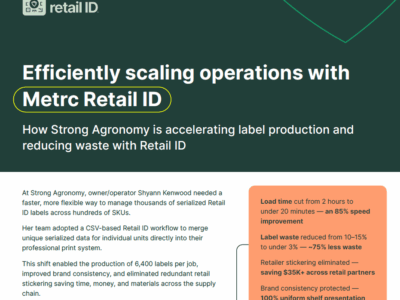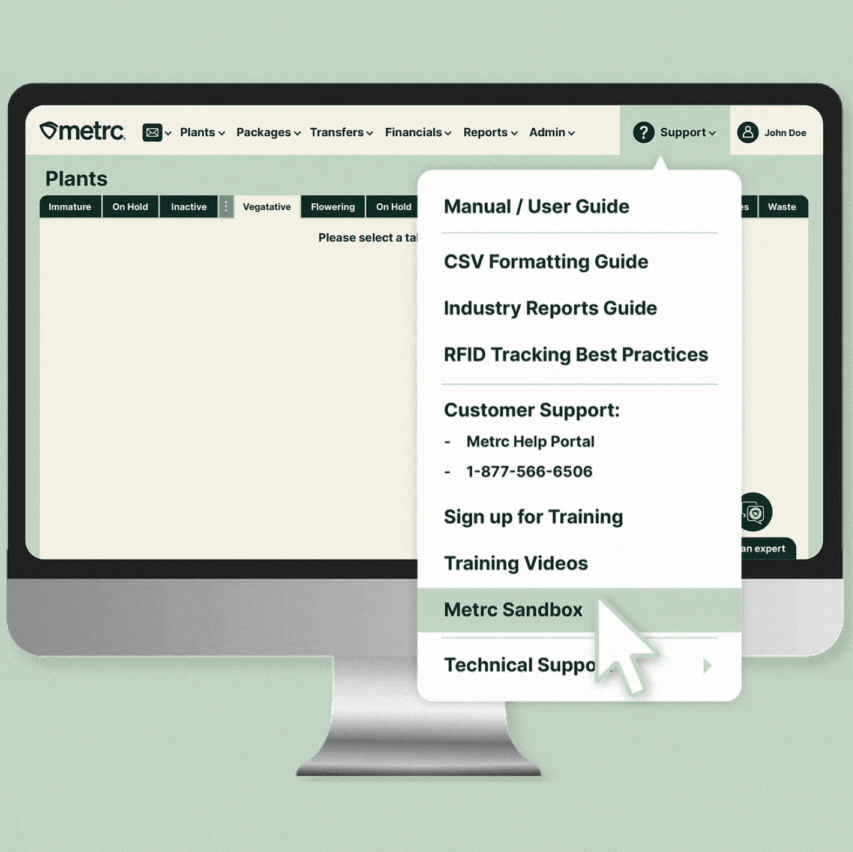Metrc is a sophisticated cannabis tracking and compliance system that empowers licensed businesses to closely monitor their plants and products throughout the entire process, from the initial seed stage to the final sale. The system offers comprehensive information and analysis to assist users in managing the well-being of their plants, demonstrating compliance with regulations, and maximizing their business efficiency.
In the competitive cannabis industry, accurate inventory traceability and regulatory compliance are essential. Metrc serves as a compliance reporting tool, enabling licensed businesses to track plant actions, inventory movements, and record sales data for regulatory purposes. To maintain operational efficiency, businesses can integrate Metrc data with external inventory management systems, ensuring both compliance and seamless inventory control. By maintaining compliant records, businesses can meet state requirements while keeping inventory traceable from seed to sale.
While Metrc does not operate as a sales tracking or inventory management system, it forms the backbone of compliance-based inventory tracking. Businesses can use this data alongside external systems for production planning, demand forecasting, and fulfillment strategies. This approach supports a reliable supply chain and ensures retail partners and end consumers receive consistent, high-quality cannabis products.
Step 1: From Mother Plants to Immature Plants
The cultivation process often begins with clippings from “mother plants” rather than seeds. These mother plants are carefully selected for their specific genetics, ensuring high-quality, consistent crops. Farmers take clippings, commonly referred to as clones, from the mother plants and place them into a growth medium to encourage root development. Once the roots are established, these clones are planted using various farming methods tailored to optimize growth.
Metrc empowers cultivators to track every step of this process, starting from the identification of mother plants and the cloning stage. With comprehensive tracking tools, cultivators can document essential details such as genetics, planting dates, and the development timeline of clones. This creates a reliable digital record that ensures compliance, transparency, and accountability.
In addition, Metrc allows cultivators to record information on additives applied throughout the growth process. While Metrc does not directly monitor variables like pH, water levels, or temperature, it provides a structured framework to integrate data from external monitoring systems. This ensures that cultivators have the tools to maintain healthy plants and mitigate issues such as pest infestations or nutrient deficiencies.
By leveraging Metrc’s robust capabilities, cultivators can streamline their operations while ensuring their crops meet the highest standards for quality and consistency.
Step 2: Growing plants
Metrc’s tracking capabilities highlight important details as the plants progress through the vegetative and flowering growth cycles. Growers can utilize the system to record and analyze parts of the production planning process – including genetics, locations, start of phase dates, and the use of fertilizers and plant treatments.
This extensive data compilation provides producers with unmatched insight into the daily development of their crops. They have the capability to stay on schedule and maintain production efficiency.
Step 3: Processing plants
Once the cannabis plants have attained complete maturity, it’s time to gather and process the yield. Growers use Metrc to document the harvesting process, recording crop weights when wet and dry, and tracking specific batches as they move through packaging, extraction, or other processing stages. By entering lab test results into Metrc, businesses maintain a traceable record of product compliance with state regulations.
The precise and detailed chain of custody data is crucial for proving adherence to regulations. Growers can use Metrc to demonstrate that every gram of harvested cannabis is accurately recorded and managed in compliance with all relevant laws and regulations. Growers can submit products for testing and track results in Metrc to reassure others across the supply chain, and end consumers, that their products meet the most stringent requirements of quality and safety during the harvesting and processing phases.
Step 4: Packaging and labeling
Following the completion of processing, the cannabis products must be packaged and labeled with precision before being distributed. Leveraging Metrc Retail ID during the labeling process enhances traceability, enabling seamless tracking from production to sale. Metrc offers producers the means to extract package information that adheres to regulatory requirements, using the extensive plant and processing records gathered throughout cultivation.
This optimizes the packaging process by limiting the possibility of errors or oversight. The Metrc system allows for every product shipped to be correctly identified, tested, processed, and monitored, thereby protecting both the licensed business and the consumer.
Disclaimer: The ability to use Metrc Retail ID for labeling may vary by state. Be sure to confirm with your state’s regulating agency whether this functionality is permitted in your jurisdiction.
Step 5: Selling products
Once growers have packaged and prepared their cannabis goods, they can then focus on wholesale sales, if applicable, and distribution through transfers. Metrc provides a robust system for overseeing these types of transfers, offering detailed historical records. Producers can use this data to gain valuable insights, such as identifying the most popular strains and determining which cultivation techniques yield the best results.
This data empowers producers to manage their product assortment, optimize inventory levels, and refine their business strategy. Metrc’s reporting features offer the necessary insights to make data-driven decisions, improving operational efficiency and ensuring a steady supply of in-demand products to distributors and retailers.
Step 6: Fulfillment
In the cannabis industry, regulatory compliance and inventory traceability are critical. While Metrc is not an inventory management system, it serves as the backbone of compliance-based tracking. Licensed businesses can integrate Metrc data with external third-party systems for production planning, demand forecasting, and fulfillment, ensuring a reliable supply chain and consistent product quality. This strengthens operational efficiency and reinforces trust with retail partners and consumers.
Step 7: Stacked retail shelves
Maintaining adequate inventory is essential in the cannabis industry. While Metrc tracks sales transactions for regulatory compliance, licensed businesses can integrate its data with external sales and inventory management systems to analyze purchasing patterns and forecast demand. This integration ensures they have the right products available to meet both current and future demand.
This data-centric approach enables cannabis businesses to enhance their product assortment and inventory management to proactively adapt offerings to match changing consumer trends, ensuring that their shelves are consistently filled with the products that customers desire.
Step 8: Final consumer sale
The ultimate stage in the cannabis supply chain is the transaction of selling the product to the final consumer. Metrc’s robust tracking system and third-party integration capabilities enables retailers to preserve meticulous records of each transaction, facilitating both regulatory compliance and analysis of customer purchasing patterns and preferences. This data drives reporting efficiency and offers the opportunity for data analysis to enable better inventory management practices, and adapt marketing or sales tactics to more effectively cater to customer preferences.
In addition, Metrc also ensures that the final consumer transaction is done in complete adherence to all regulatory requirements. Retailers can utilize the system to report and track sales receipts manually, via CSV, or through Metrc’s comprehensive point-of-sale integration to ensure a smooth and compliant experience.
Through the utilization of Metrc’s robust track-and-trace system, along with other solutions, cannabis cultivators and sellers can effectively manage and monitor their operations, ensuring comprehensive oversight and transparency throughout the process. The platform’s precise monitoring and record-keeping empower licensed businesses to efficiently adhere to regulations, enhance cultivation and sales methods, and provide consumers with quality, safe products. Metrc is an innovative solution that provides cannabis businesses with the necessary knowledge and authority to succeed in a competitive, regulated industry.
| Step | Description | Key Benefits | Compliance Checkpoints |
| 1. Seeds in the Ground | Initial planting of cannabis seeds, documenting strain, genetics, and planting details. | Precise genetic and strain tracking. | Documented planting details. |
| 2. Growing the Plant | Detailed tracking of growth conditions including irrigation, fertilizer, and environment management. | Optimal plant health and yield management. | Environmental and fertilizer records. |
| 3. Processing the Plant | Harvesting mature plants and tracking through drying and processing stages. | Efficient batch processing. | Accurate harvest and process records. |
| 4. Packaging and Labeling | Systematic packaging with compliance to labeling regulations. | Error-free labeling and packaging. | Compliance with labeling regulations. |
| 5. Selling the Product | Monitoring sales transactions and analyzing product demand. | Insights into customer preferences. | Detailed sales and revenue tracking. |
| 6. Fulfillment | Ensuring timely order fulfillment and maintaining inventory levels. | Reliable supply chain management. | Inventory and sales data accuracy. |
| 7. Stacked Retail Shelves | Keeping well-stocked shelves based on consumer demand and purchasing patterns. | Optimized inventory management. | Sales trend analysis for restocking. |
| 8. Final Consumer Sale | Transaction completion with customers, adhering to sale and receipt regulations. | Compliance in customer transactions. | Adherence to transaction regulations. |


